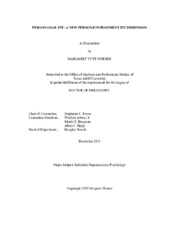| dc.description.abstract | Person-environment fit encompasses a wide variety of ways that an individual can fit with his or her environment. A new person-environment fit dimension labeled person-goal fit was introduced in the current study. Person-goal fit is defined as the congruence between an individual’s goal preferences and the goals assigned to him or her (e.g., goals assigned for work tasks). This narrow form of person-environment fit has the potential to aid in our understanding of how congruence can increase positive outcomes at work by accounting for unique variance in important job-related outcomes. Person-goal fit is proposed to be a meaningful and important dimension that can be reliably assessed and displays significant variability between individuals. As such, the purpose of this study was to establish person-goal fit as a PE fit dimension by demonstrating evidence for both construct-related and criterion-related validity. Person-goal fit was conceptualized in this study as the correspondence between two goal dimensions (i.e., difficulty, approach/avoidance) and the theoretically corresponding dispositional trait (i.e., need for achievement and approach/avoidance temperament). It was operationalized in three different ways, which were labeled objective, perceived, and subjective. The outcomes studied were goal commitment, motivation, performance, and satisfaction. This study also examined how and under what conditions person-goal fit leads to higher levels of performance. Goal-specific self-efficacy was expected to mediate, and goal commitment was expected to moderate the relationships between person-goal fit and motivation, performance, and satisfaction.
A 2 (goal difficulty: easy vs. difficult) × 2 (approach vs. avoid goal) within-subjects experiment was conducted with 365 participants, each performing four tasks. Limited construct- and criterion-related validity were found for person-goal fit. The strongest relationships were found between person-goal fit and hypothesized outcomes when person-goal fit was operationalized as a perception. No evidence was found to support the hypothesis that goal specific self-efficacy would mediate the relationships between person-goal fit and outcomes. Finally, goal commitment was found to moderate the relationships between person-goal fit and intrinsic motivation, goal satisfaction, and performance, but only with the objective operationalization of person-goal fit. The implications of these findings and directions for future person-goal fit research are discussed. | en |


